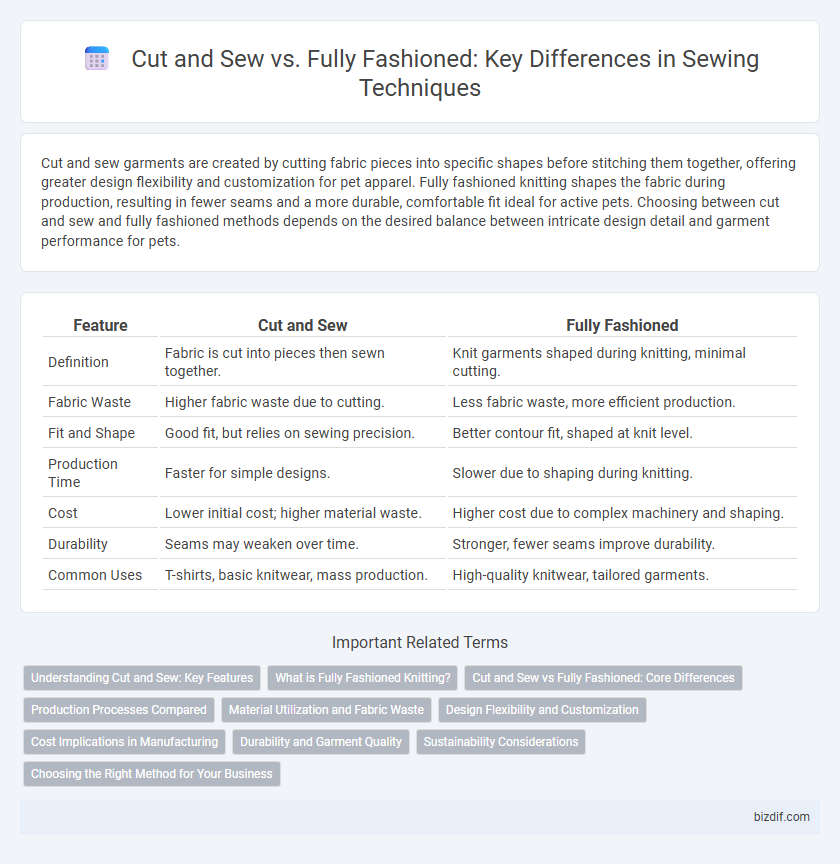Cut and sew garments are created by cutting fabric pieces into specific shapes before stitching them together, offering greater design flexibility and customization for pet apparel. Fully fashioned knitting shapes the fabric during production, resulting in fewer seams and a more durable, comfortable fit ideal for active pets. Choosing between cut and sew and fully fashioned methods depends on the desired balance between intricate design detail and garment performance for pets.
Table of Comparison
| Feature | Cut and Sew | Fully Fashioned |
|---|---|---|
| Definition | Fabric is cut into pieces then sewn together. | Knit garments shaped during knitting, minimal cutting. |
| Fabric Waste | Higher fabric waste due to cutting. | Less fabric waste, more efficient production. |
| Fit and Shape | Good fit, but relies on sewing precision. | Better contour fit, shaped at knit level. |
| Production Time | Faster for simple designs. | Slower due to shaping during knitting. |
| Cost | Lower initial cost; higher material waste. | Higher cost due to complex machinery and shaping. |
| Durability | Seams may weaken over time. | Stronger, fewer seams improve durability. |
| Common Uses | T-shirts, basic knitwear, mass production. | High-quality knitwear, tailored garments. |
Understanding Cut and Sew: Key Features
Cut and sew garments are constructed by cutting fabric pieces separately before stitching them together, allowing precise customization and intricate design placement. Key features include greater flexibility in fabric choice, patterns, and textures, which enhances the overall fit and aesthetic quality. This method contrasts fully fashioned techniques by enabling complex shapes and seams that conform closely to body contours for superior tailoring.
What is Fully Fashioned Knitting?
Fully fashioned knitting refers to a method where garments are shaped during the knitting process by increasing or decreasing stitches to create precise contours, eliminating the need for extensive cutting or sewing. This technique enhances fabric fit and reduces waste by producing pieces that match garment patterns exactly. Unlike cut-and-sew methods, fully fashioned knitting streamlines production and improves garment durability through seamless construction.
Cut and Sew vs Fully Fashioned: Core Differences
Cut and sew production involves fabric pieces being cut to size before being sewn together, allowing for greater design flexibility and customization. Fully fashioned garments are knitted to shape on specialized machines, minimizing fabric waste and enhancing fit through seamless construction. The core difference lies in cut and sew's adaptability to diverse styles versus fully fashioned's precision and efficiency in producing fitted knitwear.
Production Processes Compared
Cut and sew production involves cutting fabric pieces before stitching, allowing flexibility in design and customization with minimal fabric waste. Fully fashioned production shapes garments by knitting fabric to the exact pattern, reducing seams and ensuring precise fit, but it requires longer lead times and higher initial investment. The cut and sew process suits diverse styles and rapid prototyping, while fully fashioned excels in high-quality knitwear with sustainable fabric utilization.
Material Utilization and Fabric Waste
Cut and sew garments typically result in higher fabric waste due to the cutting process, which involves shaping individual pattern pieces from larger fabric rolls, often leaving irregular scraps. Fully fashioned knitting shapes the fabric during production, significantly reducing material waste by creating pieces that match garment contours with minimal offcuts. This method optimizes material utilization, leading to more sustainable garment manufacturing by minimizing redundancy and fabric remnants.
Design Flexibility and Customization
Cut and sew techniques offer greater design flexibility by allowing precise customization of fabric pieces before assembly, enabling intricate patterns and unique shapes. Fully fashioned garments are knitted to shape, limiting design options but improving fit and reducing material waste. For designers prioritizing creative expression and varied textures, cut and sew methods provide a broader palette for personalization.
Cost Implications in Manufacturing
Cut and sew manufacturing involves producing garments by cutting fabric pieces and sewing them together, often resulting in lower initial tooling costs and greater flexibility in design modifications. Fully fashioned garments are knitted to shape, minimizing material waste but requiring higher investment in specialized machinery and longer production setup times. The choice between cut and sew and fully fashioned impacts cost implications significantly, with cut and sew favoring short runs and customization, while fully fashioned suits high-volume production with efficiency in fabric utilization.
Durability and Garment Quality
Cut and sew garments typically offer greater durability due to reinforced seams and customizable construction methods, allowing for stronger fabric joins. Fully fashioned garments, often knitted to shape, provide superior garment quality with a seamless fit and reduced material waste, enhancing comfort and longevity. Choosing between the two depends on desired durability standards and the importance of fabric integrity in the finished product.
Sustainability Considerations
Cut and sew techniques generate more fabric waste compared to fully fashioned methods, which knit garments to shape and minimize offcuts. Fully fashioned construction supports sustainable fashion by reducing material consumption and lowering environmental impact throughout production. Brands prioritizing eco-friendly manufacturing increasingly adopt fully fashioned processes to enhance resource efficiency.
Choosing the Right Method for Your Business
Cut and sew offers unparalleled customization, allowing businesses to select specific fabrics and patterns tailored to their brand identity, making it ideal for niche markets or unique designs. Fully fashioned techniques provide enhanced garment fit and reduced waste by shaping fabric during knitting, benefiting companies prioritizing sustainability and premium quality. Businesses should evaluate their production scale, target audience, and sustainability goals to determine whether cut and sew or fully fashioned methods align best with their operational and brand objectives.
Cut and sew vs Fully fashioned Infographic

 bizdif.com
bizdif.com